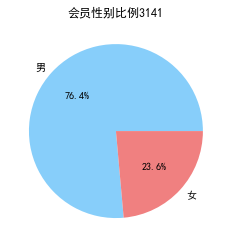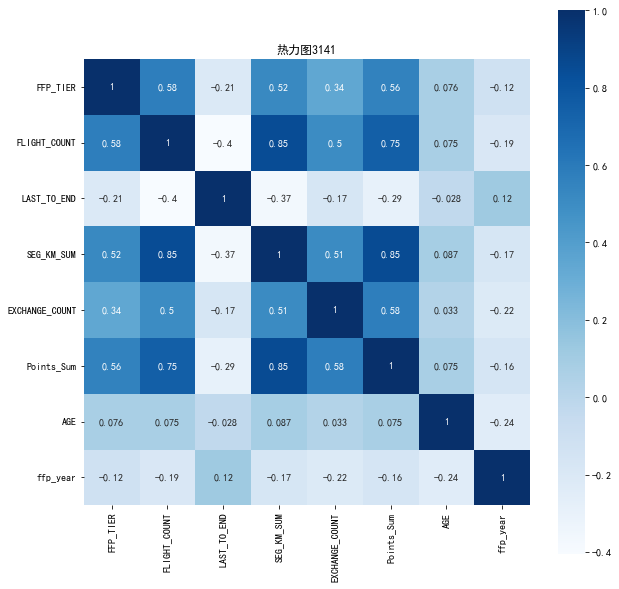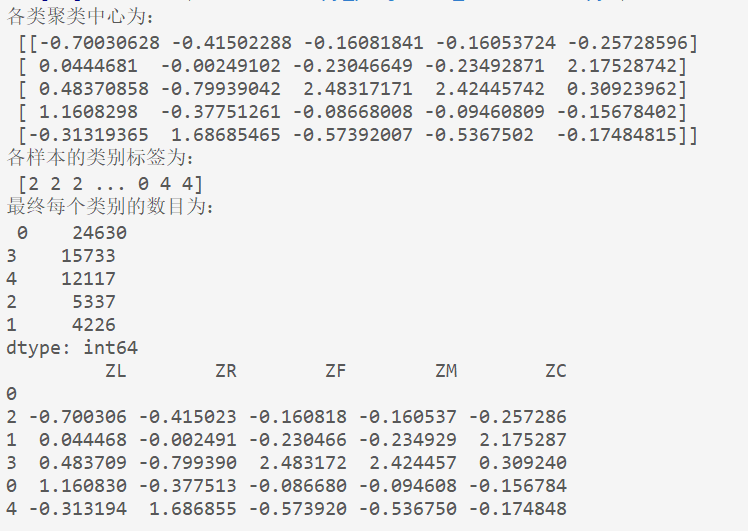数据分析第七章
航空公司客户价值分析
数据探索
import pandas as pd datafile = r"D:\py_project\a_三下\air_data.csv" resultfile = r'D:\py_project\a_三下\explore.csv' data = pd.read_csv(datafile,encoding = 'utf-8') explore = data.describe(percentiles =[],include = 'all').T explore['null'] =len(data)-explore['count'] explore = explore[['null','max','min']] explore.columns = [u'空值数',u'最大值',u'最小值'] explore.to_csv(resultfile)
用户基本信息分布
#%% 客户的基本信息分布情况 import matplotlib.pyplot as plt from datetime import datetime ffp = data['FFP_DATE'].apply(lambda x:datetime.strptime(x,'%Y/%m/%d')) ffp_year = ffp.map(lambda x : x.year) # 绘制直方图 fig = plt.figure(figsize = (8 ,5)) plt.rcParams['font.sans-serif'] = 'SimHei' plt.rcParams['axes.unicode_minus'] = False plt.hist(ffp_year, bins = 'auto', color = '#0504aa') plt.xlabel('年份') plt.ylabel('入会人数') plt.title ('各年份会员入会人数3141') plt.show() male = pd.value_counts(data['GENDER'])['男'] female = pd.value_counts(data['GENDER'])['女'] # 饼状图 fig = plt.figure(figsize=(7,4)) plt.pie([male,female],labels=['男','女'],colors=['lightskyblue','lightcoral'], autopct='%1.1f%%') plt.title('会员性别比例3141') plt.show() lv_four = pd.value_counts(data['FFP_TIER'])[4] lv_five = pd.value_counts(data['FFP_TIER'])[5] lv_six = pd.value_counts(data['FFP_TIER'])[6] fig = plt.figure(figsize = (8,5)) plt.bar(x=range(3), height = [lv_four,lv_five,lv_six], width = 0.4, alpha = 0.8, color = 'skyblue') plt.xticks([index for index in range(3)],['4','5','6']) plt.xlabel('会员等级') plt.ylabel('会员人数') plt.title('各等级人数3141') plt.show() age = data['AGE'].dropna() age = age.astype('int64') fig = plt.figure(figsize = (5,10)) plt.boxplot(age, patch_artist = True,labels = ['会员年龄'], boxprops={'facecolor':'lightblue'}) plt.title('会员年龄分布箱型图3141') plt.grid(axis='y') plt.show()




飞行次数及飞行公里数
lte = data['LAST_TO_END'] fc = data['FLIGHT_COUNT'] sks = data['SEG_KM_SUM'] #乘机时长 fig = plt.figure(figsize=(5,8)) plt.boxplot(lte, patch_artist=True, labels = ['时长'], boxprops = {'facecolor':'lightblue'}) plt.title('会员最后乘机至结束时长分布箱型图3152') plt.grid(axis='y') plt.show() plt.close fig = plt.figure(figsize=(5,8)) plt.boxplot(fc, patch_artist=True, labels = ['飞行次数'], boxprops={'facecolor':'lightblue'}) plt.title('会员飞行次数分布箱型图3141') plt.grid(axis='y') plt.show() plt.close fig = plt.figure(figsize=(5,10)) plt.boxplot(sks, patch_artist=True, labels=['总飞行公里数'], boxprops = {'facecolor':'lightblue'}) plt.title('客户总飞行公里数箱型图3141') plt.grid(axis='y') plt.show() plt.close



相关性系数矩阵及热力图
#%% 相关系数热力图 data_corr = data[['FFP_TIER','FLIGHT_COUNT','LAST_TO_END','SEG_KM_SUM','EXCHANGE_COUNT','Points_Sum']] age1 = data['AGE'].fillna(0) data_corr['AGE'] = age1.astype('int64') data_corr['ffp_year'] = ffp_year # 计算相关性矩阵 dt_corr = data_corr.corr(method='pearson') print('相关性矩阵为:\n',dt_corr) # 绘制热力图 import seaborn as sns plt.subplots(figsize=(10,10)) sns.heatmap(dt_corr,annot=True,vmax=1,square=True,cmap='Blues') plt.title('热力图3141') plt.show() plt.close


清洗空值及异常值
import numpy as np import pandas as pd datafile=r"D:\py_project\a_三下\air_data.csv" cleanedfile=r"D:\py_project\a_三下\air_data.csv" airline_data = pd.read_csv(datafile,encoding = 'utf-8') print('原始数据的形状为:',airline_data.shape) airline_notnull = airline_data.loc[airline_data['SUM_YR_1'].notnull()&airline_data['SUM_YR_2'].notnull(),:] print('删除确实记录后数据的形状为:',airline_notnull.shape) index1 = airline_notnull['SUM_YR_1']!=0 index2 = airline_notnull['SUM_YR_2']!=0 index3 = (airline_notnull['SEG_KM_SUM']>0)&(airline_notnull['avg_discount']!=0) index4 = airline_notnull['AGE']>100 airline = airline_notnull[(index1 | index2)&index3&~index4] print('数据清洗后数据的形状为:',airline.shape) airline.to_csv(cleanedfile)

属性选择、构造与数据标准化
cleanedfile=r"D:\py_project\a_三下\data_cleaned.csv" airline = pd.read_csv(cleanedfile,encoding='utf-8') airline_selection = airline[['FFP_DATE','LOAD_TIME','LAST_TO_END','FLIGHT_COUNT','SEG_KM_SUM','avg_discount']] print('筛选的属性前5行为:\n',airline_selection.head()) # 属性构造,数据标准化 L = pd.to_datetime(airline_selection['LOAD_TIME'])-\ pd.to_datetime(airline_selection['FFP_DATE']) L = L.astype('str').str.split().str[0] L = L.astype('int')/30 airline_features = pd.concat([L,airline_selection.iloc[:,2:]],axis=1) print('构建的LRFMC属性前5行为:\n',airline_features.head()) from sklearn.preprocessing import StandardScaler data = StandardScaler().fit_transform(airline_features)
np.savez(r'D:\py_project\a_三下\airline_scale.npz',data) print('标准化后LRFMC 5个属性为:\n',data[:5,:])

聚类
from sklearn.cluster import KMeans # 导入kmeans算法 # 读取标准化后的数据 airline_scale = np.load(r'D:\py_project\a_三下\airline_scale.npz')['arr_0'] k = 5 # 确定聚类中心数 # 构建模型,随机种子设为123 kmeans_model = KMeans(n_clusters=k,random_state=123) fit_kmeans = kmeans_model.fit(airline_scale) # 模型训练 # 查看聚类结果 kmeans_cc = kmeans_model.cluster_centers_ # 聚类中心 print('各类聚类中心为:\n',kmeans_cc) kmeans_labels = kmeans_model.labels_ # 样本的类别标签 print('各样本的类别标签为:\n',kmeans_labels) r1 = pd.Series(kmeans_model.labels_).value_counts() # 统计不同类别样本的数目 print('最终每个类别的数目为:\n',r1) # 输出聚类分群的结果 cluster_center = pd.DataFrame(kmeans_model.cluster_centers_,\ columns=['ZL','ZR','ZF','ZM','ZC']) # 将聚类中心放在数据框中 cluster_center.index = pd.DataFrame(kmeans_model.labels_ ).\ drop_duplicates().iloc[:,0] # 将样本类别作为数据框索引 print(cluster_center)

雷达图
import matplotlib.pyplot as plt # 客户分群雷达图 labels = ['ZL','ZR','ZF','ZM','ZC'] legen = ['客户群' + str(i + 1) for i in cluster_center.index] # 客户群命名,作为雷达图的图例 lstype = ['-','--',(0, (3, 5, 1, 5, 1, 5)),':','-.'] kinds = list(cluster_center.iloc[:, 0]) # 由于雷达图要保证数据闭合,因此再添加L列,并转换为 np.ndarray cluster_center = pd.concat([cluster_center, cluster_center[['ZL']]], axis=1) centers = np.array(cluster_center.iloc[:, 0:]) # 分割圆周长,并让其闭合 n = len(labels) angle = np.linspace(0, 2 * np.pi, n, endpoint=False) angle = np.concatenate((angle, [angle[0]])) # 绘图 fig = plt.figure(figsize=(8,6)) ax = fig.add_subplot(111, polar=True) # 以极坐标的形式绘制图形 plt.rcParams['font.sans-serif'] = ['SimHei'] # 用来正常显示中文标签 plt.rcParams['axes.unicode_minus'] = False # 用来正常显示负号 # 画线 for i in range(len(kinds)): ax.plot(angle, centers[i], linestyle=lstype[i], linewidth=2, label=kinds[i]) # 添加属性标签 ax.set_thetagrids(angle * 180 / np.pi, labels) plt.title('客户特征分析雷达图3141') plt.legend(legen) plt.show() plt.close




